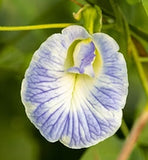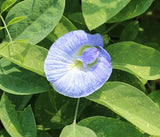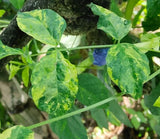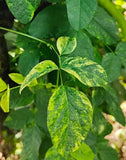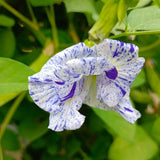These seeds were collected from variegated Single Clitoria ternatea plants which have flowers that are blue and white. Growing to lengths of 15 feet this tropical vine attracts a number of birds, bees, and butterflies. From the middle of Summer to early Fall this breathtaking vine blooms colors of Dark Blue, Blue, Violet, Purple, and white. This plant likes to live in full sun to partial shade. This plant is a larval host of the Long-tailed Skipper and Dorantes Longtail butterflies. This is a tender perennial in USDA Hardiness Zones 9 to 11, but can be grown as an annual in all USDA Hardiness Zones.
Experience the magic of Clitoria ternatea Variegated Single Blue and White with these seeds. This striking vine produces elegant bi‑colored blossoms, each petal a delicate fusion of deep sapphire and pure white. Hardy in USDA Zones 9 through 11, this vigorous climber thrives in warm climates and can tolerate light frosts in cooler regions.
Famed for its vibrant blooms, the plant is also celebrated as a symbol of peace and harmony in several Asian cultures. In Cambodia it is called Pka Clitoria and plays a role in traditional ceremonies while in Thailand it is used to craft vibrant blue tea. Drink derived from its petals reacts with pH to change hue from blue to purple, making tea rituals both beautiful and symbolic.
Each bloom emits a faint, sweet fragrance that drifts gently on summer breezes. This plant supports a lively gathering of pollinators. Bees and butterflies flock to its nectar rich flowers, while ladybugs often appear attracted by the insect biodiversity it fosters. Certain moths and butterflies even choose Clitoria ternatea as a larval host making your garden a sanctuary for these delicate creatures.
Here are some captivating highlights:
• Bi‑colored blooms in shades of deep blue and crisp white create visual contrast
• Delightful sweet fragrance draws in pollinators and enhances sensory appeal
• Supports bees, butterflies, moths and ladybugs as food sources and host plant
• Cultural connections in Southeast Asia include tea making, symbolism and ceremonies
• pH sensitive petals that change color offer an interactive botanical display
• Thrives in USDA Hardiness Zones 9–11, adapting to warm and subtropical climates
Plant these seeds and cultivate a living tapestry rich in visual charm, cultural resonance, and garden wildlife appeal.






